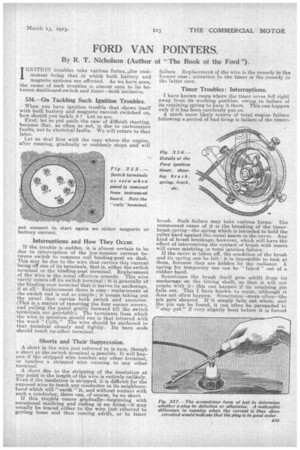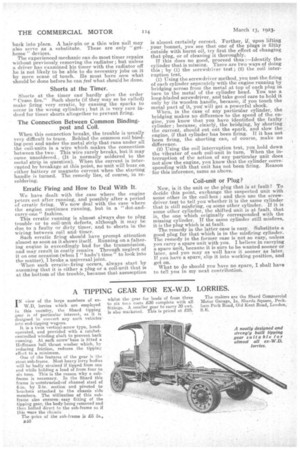FORD VAN POINTERS.
Page 27

Page 28

If you've noticed an error in this article please click here to report it so we can fix it.
By R. T. Nicholson (Author of "The Book of the Ford ").
iGNITION troubles take various forms, ,the conimonest being that in which both battery and magneto systems are affected. As we have seen, the cause of such troubles is almost sure to lie between dashboard-switch and timer—both inclusive.
534.—On Tackling Such Ignition Troubles.
When you have ignition trouble that shows itself with both battery and magneto current switched on, how should you tackle it 7 Let us see. First, let us put aside the case of difficult starting, because that, as often as not, is due to carburation faults, not to electrical faults. 'We will return to that later.
Let us deal first with the case where the engine, after running, gradually or suddenly stops and will
Interruptions and How They Occur.
If the trouble is sudden, it is almost certain to be due to interruption of the low-tension current between switch to common coil binding-post on dash. This may be due to the wire that carries-this current ' being off one. of its terminals, that is, either the switch • terminal or the binding-post terminal. Replacement • of the wire is the. usual effective remedy. This wire rarely comes off its switch terminal ; it is generally at the binding-post terminal that it leaves its anchorage, if at all.Replacement there is easy : replacement at the switch end is not so simple ; it means taking out the panel that carries both switch and ammeter. (This is a matter of removing the four corner screws, and pulling the panel gently forward till the switch • terminals are getatable). The terminals from which the wire in question should run is that lettered with the word "Coils." The wire should be anchored to that terminal cleanly and tightly. Its bare ends should touch no other terminal.
Shorts and Their Suppression.
A short in the wire just referred to is rare, though a short at the switch terminal is possible. It will happen if the stripped wire touches -any other terminal, or touches a stripped wire running to any other terminal.
A short due to the stripping of the insulation at any point in the length of the wire is entirely unlikely. Even if the insulation is stripped, it is difficult for the exposed wire to touch any conductor in its neighbourhood which will." earth" it, and without contact with such a conductor, there can, of course, be no short.
If this trouble comes gradually—beginning with occasional misfiring and ending in no firing—it may usually be traced either to the wire just referred to getting loose and then coming adrift, or to timer
failure. Replacement of the wire is the remedy in the former case; attention to the timer is the remedy iu the latter case.
Timer Troubles: Interruptions.
have known cases where the timer cover fell right away from its working position, owing to failure of its retaining swing to keep it thefe. This can happen only if it has been carelessly put on. A much more likely source of total engine failure following a period of bad -firing is failure of the timer brush. Such failure may take various forms. The commonest cause of it is the breaking of the timerbrush spring—the spring which is intended to hold the roller hard against the metal insets in the cover. Any kind of brush breakage, however, which will have the effect of interrupting the contact of brush with insets will cause misfiring or total ignition failure.
If the cover is taken off, the condition of the brush and its spring can be felt : it is impossible to look at them, because they are hidden by the radiator. A spring for temporary use can be " faked " out of a rubber band.
Sometimes the brush itself gets adrift from its anchorage on the timing shaft, so that it will not rotate with it : this can happen if its retaining pin falls out. This I have known to occur, although it does not often happen. Sometimes—more often—the pin gets sheared. If it simply -falls out whole, and the pin can be found, it can often be persuaded to " stay put" if very slightly bead before it is forced back into place. A hair-pin or a thin wire nail may also serve as a substitute. These are only " gethome " devices.
The experienced mechanic can do most timer repairs 'without previously removing the radiator ; but unless a driver has examined his timer with the radiator off he is not likely to be able to do necessary jobs on it by mere sense of touch. He must have seen what should be done before he can feel what should be done.
Shorts at the Timer.
Shorts at the timer can hardly give the order "Cease fire." Such shorts (if they may so be called) make firing very erratic, by causing the sparks to occur in the wrong cylinders; but it is very rare indeed for timer shorts altogether to prevent firing.
The Connection Between Common Bindingpost and Coil.
When this connection breaks, the trouble is usually very difficult to trace. Behind the common coil binding-post and under the metal strip that runs under all the coil-units is a wire which makes the connection between the two This wire rarely breaks, but it may come unsoldered.. (It is normally soldered to the metal strip in question). When the current is interrupted by breakage at this point, no unit will buzz on either battery or magneto current when the starting handle is turned. The remedy lies, of course, in resoldering.
Erratic Firing and How to Deal With It.
We have dealt with the case where the engine peters out after running, and possibly after a period of erratic firing. We now deal with the case where the engine continues running, but in a " dot-andcarry-one " fashion.
This erratic running is almost always due to plug trouble or to coil-unit defects, although it may he due to a faulty or dirty timer, and to .shorts in the wiring between coil andtimer. Such erratic firing should have prompt attention almost as soon as it shows itself. Running on a faltering engine is exceedingly bad for the transmission, and may result in costly repairs Through neglect of it on one occasion (when I "hadn't time" to look into the matter), I broke a universal joint. When such erratic+ firing occurs, alWays start by assuming that it -is either a plug or a coil-unit that is at the bottom of the trouble, because that assumption
is almost certainly correct. Further, if, upon lifting your bonnet, you see that on of the plugs is filthy outside with burnt oil, try first the effect of changing that plug, or of cleaning it thoroughly. If this does no good, proceed thus :—Identify the cylinder that is missing. There are two ways of doing this ; by (1) the screwdriver test ; (2) •the coil interruption test; (1) fling the screwdriver method, you test the firing of each cylinder separately with the engine running by bridging across from the metal at top of each plug in turn to the metal of the cylinder head. You use a long-bladed screwdriver, and take good care to hold it only by its wooden handle, because, if you touch the metal part of it, .you:' will get a powerful shock. , When, in the case of any particular cylinder, the bridging makes no difference to the speed of the engine, you know that you have identified the faulty cylinder ; because, clearly, the bridging, by shorting the current, should cut out the spark, and slow the engine, if that cylinder has been firing. If it has not been firing, the shorting can, of course, make no difference.
(2) Using the coil interruption test, you hold down the vibrator of each coil-unit in turn. When the interruption of the action of any particular unit does not slow the engine, you know that the cylinder corresponding with that unit has not been firing. Reason for this inference, same as above. '
Coil-unit or Plug?
Now, is it the unit or the plug that is at fault? To decide this point, exchange the suspected unit with some other in the coil-box ; and then use the screwdriver test to tell you whether it is the same cylinder that is still misfiring, or some other cylinder. If it is some other cylinder, the shifted Unit is at fault, that is, the one which originally corresponded with the missing cylinder. If the same Cylinder still misfires, it is the plug which is at fault.
The remedy in the latter case is easy. •Substitute a good plug for that which is in the misfiring cylinder. The remedy in the former case is not so easy, unless you carry a spare unit With you. I believe in carrying a spare unit, because it is sure to be wanted sooner or ater, and you may as well have it sooner as later. If you have a spare, slip it into working position, and get on.
What to qo should ycu have no spare, I shall have o tell you in my next contribution.
































